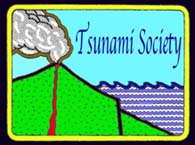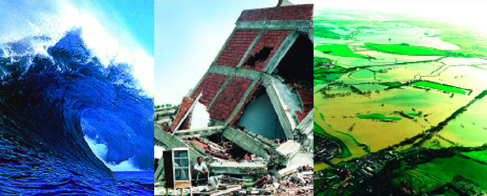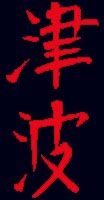..........................................................
ABSTRACTS
for Volume 31, No. 1
Complete Journal - STHVol31N1Y2012 (Compressed PDF 5.3 MB)(uncompressed 98.8 MB)
..........................................................
SIMULATION OF THE EFFECT OF FAR FIELD TSUNAMI THROUGH AN OPEN BOUNDARY CONDITION IN A BOUNDARY-FITTED CURVILINEAR GRID SYSTEM (2.9 MB) (compressed 2 MB)
Mohammed Ashaque Meah - Dept. of Mathematics, Shahjalal University of Science & Technology, BANGLADESH
Ahmad Izani M Ismail - School of Mathematical Sciences, University Sains Malaysia, 11800 Pulau Pinang, MALASIA
Md. Fazlul Karim - Faculty of Engineering, Brunei Institute Technology, BRUNEI
Md. Shafiqul Islam - Dept. of Mathematics, Shahjalal University of Science & Technology, BANGLADESH
ABSTRACT
A new approach is developed to simulate the effect of far field tsunami in a limited area model domain where the coastal and Island boundaries are curvilinear in nature and the bending is high. The model is designed in a boundary fitted curvilinear grid system. To simulate the effect of far field tsunami, it is considered that the tsunami source is located far away from the model domain. The coastal and island boundaries and the other open boundaries of the model domain are represented by some functions so as to generate the boundary fitted grids. To use the regular finite difference scheme a transformation is used so that the physical domain is transformed into a rectangular one. The transformed shallow water equations are then solved in the transformed domain. The response of the tsunami source due to 26 December 2004 Indonesian tsunami is computed along the western open boundary of the model domain. Based on the response of the tsunami source, an appropriate boundary condition is formulated to simulate the effect of far field tsunami along the coastal belt. All simulations show excellent agreement with the observed data.
Key Words: Boundary-fitted curvilinear grids, Open boundary condition, Far field tsunami, Shallow water equations, Tsunami source, Indonesian tsunami 2004.
Science of Tsunami Hazards, Vol. 31, No. 1, pages 1 - 19 (2012)
------------------------
THE SAMOA TSUNAMI OF 29 SEPTEMBER 2009 - Early Warning and Inundation Assessment (compressed file, 1.2 MB),
Giovanni Franchello - European Commission, Joint Research Centre, Institute for the Protection and Security of the Citizen, Ispra (VA), ITALY
Alessandro Annunziato - European Commission, Joint Research Centre, Institute for the Protection and Security of the Citizen, Ispra (VA), ITALY
ABSTRACT
On 29 September 2009 at 17:48:11 UTC, a large earthquake of magnitude 8 struck off-shore of the Samoa Islands and generated a large tsunami that destroyed several villages and caused more than 160 fatalities. This report first presents the characteristics of the earthquake and discusses the best estimations for the fault parameters, which are the necessary input data for the hydrodynamic tsunami calculations. Then, the assessment of the near-real time systems invoked by the Global Disasters Alert and Coordination System (GDACS) and the post-event calculations are performed, making comparisons with the observed tidal measurements and post-event survey. It was found that the most severely damaged locations are the Southern section of the Western Samoa Islands, Tutuila Isl in American Samoa and Niuatoputapu Isle in Tonga. This is in agreement with the locations indicated by the Red Cross as the most affected and with the results of the post-tsunami surveys. Furthermore, an attempt was made to map the inundation events using more detailed digital elevation models (DEM) and hydrodynamic modelling with good results. The flooded areas for which we had satellite images and post-tsunami surveys confirm the inundated areas identified correctly by the hydrodynamic model. Indications are given on the DEM grid size needed for the different simulations.
Key words: GDACS; 2009 Samoa tsunami, tsunami propagation and inundation; early warning system; fault model; DEM assessment
Science of Tsunami Hazards, Vol. 31, No. 1, pages 19 - 61 (2012)
------------------------
A STUDY OF THE EFFECT OF PERMEABILITY OF ROCKS IN TSUNAMI GENERATION AND PROPAGATION BY SEISMIC FAULTING USING LINEARIZED SHALLOW – WATER WAVE THEORY (uncompressed 4.2 MB) (compressed 1.5 MB)
Parul Saxena - Dept of Mathematics, Jaypee Institute of Information Technology, Nodia, INDIA
Lokendra Kumar - Dept of Mathematics, Jaypee Institute of Information Technology, Nodia, INDIA
ABSTRACT
The effect of permeability of rocks inside the ocean on Tsunami generation and Propagation is investigated. We study the nature of Tsunami build up and propagation using realistic curvilinear source models. The models are used to study the effect of permeability on tsunami amplitude amplification as a function on spreading velocity and rise time. Effect of permeability on Tsunami waveforms within the frame of the linearized shallow water wave theory for constant water depth are analyzed analytically using Transform methods. It is observed that in the region of highly permeable rocks the tsunami wave run is fast in comparison to low permeable rocks. The amplitude as a function of the propagated uplift length and width are analyzed. The cases of Tsunami-2011 (Japan), Tsunami-2006 (Srilanka), and Tsunami-2006 (Madras) have been demonstrated in the study.
Keywords: Tsunami Modeling, Water wave, permeability, Laplace and Fourier Transforms
Science of Tsunami Hazards, Vol. 31, No. 1, pages 62 - 81 (2012)
------------------------
ALGERIA’S VULNERABILITY TO TSUNAMIS FROM NEAR-FIELD SEISMIC SOURCES (14 MB) (Compressed 430 Kb)
L. Amir - USTHB-FSTGAT, BP 32, Bab Ezzouar, Algiers, ALGERIA
A. Cisternas - Universidad De Chile, Santiago, CHILE
J. -L. Vigneresse- UHP, UMR 7566, Vandoeuvre les Nancy, FRANCE
W. Dudley - University of Hawaii, Hilo, Hawaii, USA
B. Mc Adoo - Vassar College, Poughkeepsie, NY, 12601 USA
ABSTRACT
Evaluation of the effects of tsunami damage relative to earthquake damage may help to identify critical coastal zone structures and exposed populations for near field tsunami risk. In this work, we propose to define the ratio between tsunami intensity and earthquake intensity as a measure of near field tsunami vulnerability for coastal communities. This parameter is estimated for 13 tsunami events reported in North Algeria from the 14th century to present. Although the results show that there are no tsunamis that are unusually large for the size of the earthquake that generated them, coastal communities remain at risk from these periodic hazards. We also use tsunami modelling and published information to estimate maximum inundation in Northern Algeria. Then, we generate a flooding map, which reveals the communities, buildings and infrastructure that are exposed to the tsunami hazard. This map shows that the majority of the people in Algiers and Oran live above 5 meters in elevation, and are hence not exposed to the hazard. Despite this, the coastline remains vulnerable to tsunami as earthquakes can damage poorly constructed buildings and other infrastructure, weakening it prior to the arrival of the tsunami. To increase resilience in the coastal zone, tsunami and earthquake awareness, education and preparedness must become a priority in the context of regional early warning programs.
Science of Tsunami Hazards, Vol. 31, No. 1, pages 82 - 98 (2012)
Copyright © 2012 - TSUNAMI SOCIETY INTERNATIONAL
-------------------------------------------------------------------------------------------------------------------------------------------




